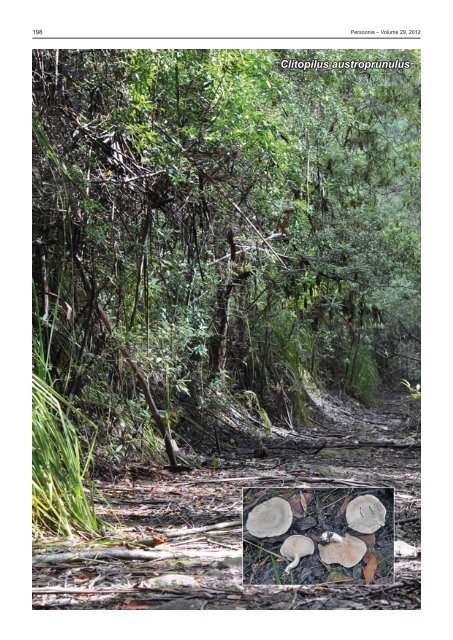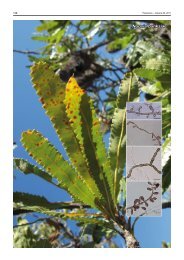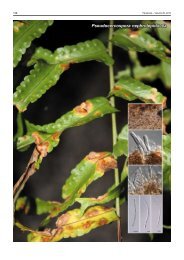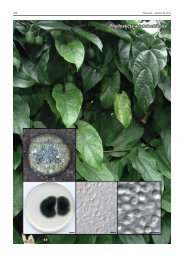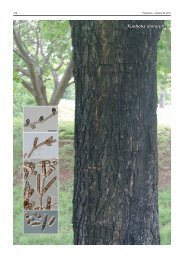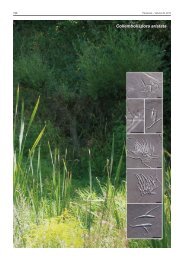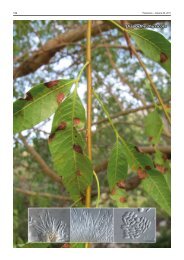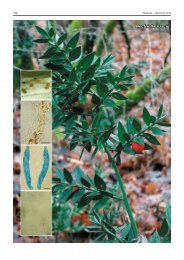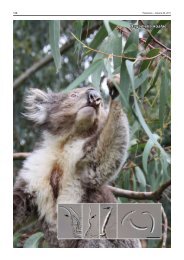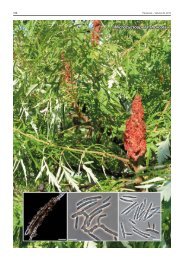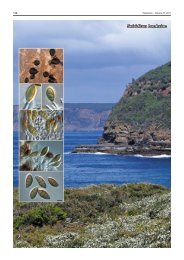Clitopilus austroprunulus - Fungal Planet
Clitopilus austroprunulus - Fungal Planet
Clitopilus austroprunulus - Fungal Planet
Create successful ePaper yourself
Turn your PDF publications into a flip-book with our unique Google optimized e-Paper software.
198 Persoonia – Volume 29, 2012<br />
<strong>Clitopilus</strong> <strong>austroprunulus</strong>
<strong>Fungal</strong> <strong>Planet</strong> description sheets<br />
199<br />
<strong>Fungal</strong> <strong>Planet</strong> 153 – 20 December 2012<br />
<strong>Clitopilus</strong> <strong>austroprunulus</strong> Morgado, G.M. Gates & Noordel., sp. nov.<br />
Etymology. austro (L) = southern, being a southern counterpart of <strong>Clitopilus</strong><br />
prunulus.<br />
Macroscopic description — Pileus 40–90 mm diam, convex<br />
when young, expanding to concave or infundibuliform,<br />
with involute margin, becoming irregularly shaped with age<br />
with undulating marginal zone. Not hygrophanous, not translucently<br />
striate, uniformly pale grey, sometimes with a slight<br />
brown tinge at the centre (10YR 7/3–4), adpressed-tomentose<br />
all over. Lamellae arcuate-decurrent, grey-pink with entire,<br />
concolorous or more or less hyaline edge, crowded. Stipe<br />
30–60 × 10–15 mm (apex), usually central, rarely eccentric,<br />
tapering towards base, white or with a greyish brown tinge<br />
like pileus, tomentose. Context white, firm and rather thick in<br />
pileus. Odour very strongly farinaceous-rancid. Taste farinaceous-rancid.<br />
Microscopic description — Spores (8–)9–11 × 4.5–6 µm,<br />
Q = 1.7–2.1, Qav = 1.9, slender fusiform occasionally amygdaliform,<br />
thin-walled, distinctly ribbed lengthwise with 5–8<br />
longitudinal ribs, angular in polar view. Basidia 20–30 × 4–8<br />
µm, 4-spored. Lamella edge fertile or with scattered subcylindrical<br />
cheilocystidia, 20–40 × 4–11 µm. Pileipellis a cutis of<br />
densely packed, narrow cylindrical, 4–8 µm wide hyphae with<br />
dark brown coloured walls, and scattered fine encrustations.<br />
Clamp-connections absent.<br />
Habitat — Terrestrial in litter on wet sclerophyll forest of<br />
Eucalyptus regnans with an understorey of Acacia, Olearia,<br />
Bedfordia, Pomaderris and Phebalium.<br />
Typus. Australia, Tasmania, Kermandie Falls, Lower Track, S43°12'<br />
E146°52', 24 Mar. 2009, M.E. Noordeloos 2009062 (L); ITS sequence Gen-<br />
Bank KC139085, MycoBank MB802264.<br />
Notes — The morphospecies <strong>Clitopilus</strong> prunulus is widespread<br />
in Europe and North America. A number of closely related<br />
species have been described in literature (Hausknecht<br />
& Noordeloos 1998, Yang 2007, Vizzini et al. 2011). Species<br />
limits are however often difficult to define due to the lack of<br />
good morphological characters. Recent studies confirm that<br />
the current concept of C. prunulus is polyphyletic (Hartley<br />
et al. 2009, Vizzini et al. 2011). <strong>Clitopilus</strong> <strong>austroprunulus</strong> is<br />
very similar morphologically to C. prunulus from Europe, and<br />
therefore Noordeloos & Gates (2012) initially listed it as <strong>Clitopilus</strong><br />
cf. prunulus. However, a phylogenetic analysis based<br />
on internal transcribed spacer (ITS) sequences derived from<br />
two C. <strong>austroprunulus</strong> isolates and previously published data<br />
(Co-David et al. 2009, Hartley et al. 2009, Vizzini et al. 2011)<br />
clearly showed that the collections of C. <strong>austroprunulus</strong> cluster<br />
together as a clade of their own, phylogenetically distinct<br />
from the rest of the C. prunulus clade. The other closely related<br />
species, C. cystidiatus and C. chrischonensis are phylogenetically<br />
distinct and differ from C. <strong>austroprunulus</strong> in morphology<br />
by the abundant presence of cheilocystidia. Although<br />
judging from the phylogeny presented here, the occurrence of<br />
cheilocystidia may well be of limited value in the systematics<br />
of this group. <strong>Clitopilus</strong> amygdaliformis described from China<br />
(Yang 2007) is also closely related, but differs in spore and<br />
stipe morphology. Unfortunately, sequences for this species<br />
are not available in public databases and therefore it was not<br />
included in the phylogenetic analysis.<br />
A multi-gene maximum-likelihood phylogeny based on four<br />
independent genetic markers (data not shown) yielded the<br />
same conclusions as the ITS phylogeny presented here.<br />
Therefore C. <strong>austroprunulus</strong> is phylogenetically distinct from<br />
all sequenced species and morphologically distinct from all<br />
described species without available sequences.<br />
Maximum-likelihood phylogram (-ln L = 3770.9401) of ITS<br />
sequence analysis with general-time-reversible model using<br />
Garli 2.0 (Zwickl 2006), showing the phylogenetic position<br />
of <strong>Clitopilus</strong> <strong>austroprunulus</strong> (in bold) generated in this study<br />
among representatives of closely related taxa with sequences<br />
deposited in GenBank and the UNITE database. Branches<br />
with bootstrap support (BS) ≥ 0.70 (based on 100 replicates)<br />
and/or bayesian posterior probability (PP) ≥ 0.95 (based on<br />
5 000 generations) (Ronquist et al. 2012) are thickened with<br />
BS/PP values indicated above the branches. The tree was<br />
rooted with Lepista sordida and Lyophyllum decastes.<br />
Additional collections Australia, Tasmania, Kermandie Falls, Lower<br />
Track, S43°12' E146°52', 16 Mar. 1999, G. Gates E 226; ibid., 23 May 2000,<br />
G. Gates E 936; ibid., 5 Apr. 2001, G. Gates E 1072; ibid., 16 May 2002,<br />
G. Gates E 1508; ibid., 10 Apr. 2003, G. Gates E 1694; ibid., Upper Track,<br />
26 Apr. 2001, G. Gates E 1131; Reuben Falls, 15 May 1999, G. Gates E<br />
507; Tahune, hanging bridges walk, S43°06', E146°43', 14 Mar. 2009, M.E.<br />
Noordeloos 2009001 (L), ITS sequence GenBank KC139084.<br />
Colour illustrations. Australia, Tasmania, Kermandi Falls, Lower Track,<br />
type-locality. <strong>Clitopilus</strong> <strong>austroprunulus</strong>, holotype (photo’s M.E. Noordeloos).<br />
Luis N. Morgado, Machiel E. Noordeloos, National Herbarium of the Netherlands, Naturalis Biodiversity Center, Leiden University,<br />
P.O. Box 9514, 2300 RA Leiden, The Netherlands; e-mail: luis.morgado@naturalis.nl; chiel.noordeloos@naturalis.nl;<br />
Genevieve Gates, School of Plant Science, University of Tasmania, Hobart, Australia; e-mail: Genevieve.Gates@utas.edu.au.<br />
© 2012 Nationaal Herbarium Nederland & Centraalbureau voor Schimmelcultures


